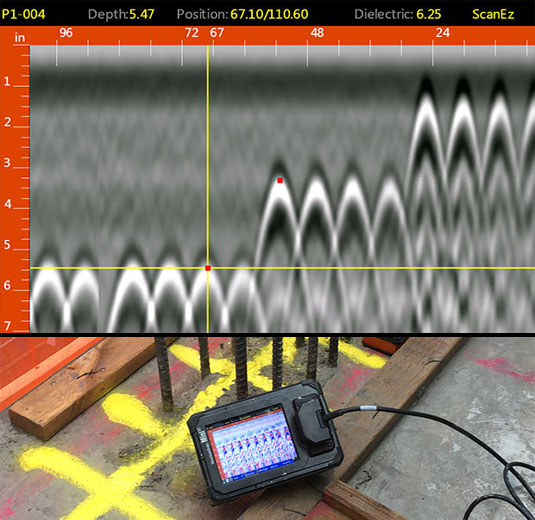The Ultimate RainierGPR Concrete Scanning Service Described
The Ultimate RainierGPR Concrete Scanning Service Described
Blog Article
Checking Out the Depths: A Comprehensive Overview to Concrete Scanning and Its Diverse Applications
In the realm of construction and facilities development, the careful procedure of concrete scanning holds a pivotal role in guaranteeing the architectural integrity and security of jobs. As innovation continues to advance, the applications of concrete scanning have actually broadened far past mere surface-level assessments.
Relevance of Concrete Scanning
Recognizing the value of concrete scanning is vital in making certain the safety and integrity of structures throughout building and construction and restoration jobs. Concrete scanning makes use of sophisticated modern technologies such as ground-penetrating radar (GPR) and electro-magnetic induction to detect ingrained objects, voids, or various other anomalies within concrete structures.
Additionally, concrete scanning plays a critical duty in making certain conformity with building regulations and guidelines that mandate the defense of existing architectural parts throughout building and construction tasks. By properly mapping out the interior make-up of concrete, scanning innovations make it possible for building experts to make informed decisions that support the architectural stability and durability of structures and infrastructure projects. Essentially, the value of concrete scanning lies in its ability to secure both the structural stability and the personnel associated with building endeavors.
Technologies Made Use Of in Concrete Scanning
Concrete scanning relies on innovative modern technologies such as ground-penetrating radar (GPR) and electromagnetic induction to properly discover embedded things and anomalies within concrete structures. Ground-penetrating radar runs by giving off high-frequency electro-magnetic waves right into the concrete. When these waves encounter different products or gaps within the concrete, they bounce back to the surface, enabling the GPR system to develop a thorough subsurface image. This innovation is particularly reliable in finding rebar, post-tension cable televisions, avenues, and other objects installed in concrete.
Electro-magnetic induction, on the various other hand, functions by generating electromagnetic areas around a concrete structure through a transmitter coil. When steel items exist within the concrete, they interfere with these electro-magnetic fields, causing eddy currents to stream through the metal. By determining the adjustments in the electromagnetic areas with a receiver coil, the system can determine the place of metallic objects in the concrete.
These sophisticated technologies play a vital role in non-destructive testing, ensuring the security and stability of concrete frameworks in different sectors.
Applications in Building Industry
Within the building and construction industry, concrete scanning modern technology locates diverse applications that boost job performance and security. Additionally, concrete scanning is used for situating gaps, such as air pockets or locations of wear and tear within concrete, which can jeopardize the general stamina of a framework. Concrete scanning plays a critical function in high quality control by verifying the density of concrete covers over reinforcement, guaranteeing compliance with style requirements and criteria.

Security Benefits of Concrete Scanning
In the realm of building safety, the execution of concrete scanning modern technology provides an extremely important advantage in preemptively identifying prospective dangers and fortifying structural integrity. By using sophisticated scanning techniques such as ground-penetrating radar (GPR) and electromagnetic induction, building groups can properly locate rebar, post-tension wires, channels, and other covert objects within concrete structures. This positive technique dramatically minimizes the risk of accidental strikes throughout view website boring, cutting, or coring activities, thus protecting against costly problems, injuries, and project hold-ups.
Moreover, concrete scanning enhances employee safety by giving real-time information about the structural condition of concrete aspects. By dealing with potential safety concerns quickly, concrete scanning contributes to creating a safe and secure working setting and minimizing the probability of structural failures or crashes on building websites.
Future Patterns in Concrete Scanning
Arising improvements in scanning modern technology are poised to revolutionize the field of concrete assessment and analysis. One major trend that is gaining grip is the combination of Learn More expert system (AI) and artificial intelligence formulas right into concrete scanning tools. By taking advantage of the power of AI, these systems can assess large quantities of information collected throughout scanning processes to provide more thorough and precise insights into the problem of concrete frameworks. This can aid in identifying covert flaws, predicting prospective structural failures, and also suggesting upkeep approaches.
Another considerable pattern is the advancement of even more user-friendly and portable scanning tools. Miniaturization of scanning tools enables for easier accessibility to restricted areas and remote areas, making inspections more comprehensive and reliable. Additionally, innovations in wireless interaction modern technologies make it possible for real-time data transfer and evaluation, facilitating quicker decision-making procedures.
Additionally, there is an expanding focus on sustainability in concrete scanning technologies - RainierGPR Concrete Scanning. Makers are significantly integrating environment-friendly materials and energy-efficient functions into their devices to lower environmental influence. These future patterns are readied to boost the efficiency, accuracy, and sustainability of concrete scanning methods, shaping the market's future landscape
Verdict
In verdict, concrete scanning plays a critical role in the construction industry by making sure the safety and effectiveness of numerous jobs. As innovation developments, the future of concrete scanning holds promising advancements for enhancing building and construction processes.

Report this page